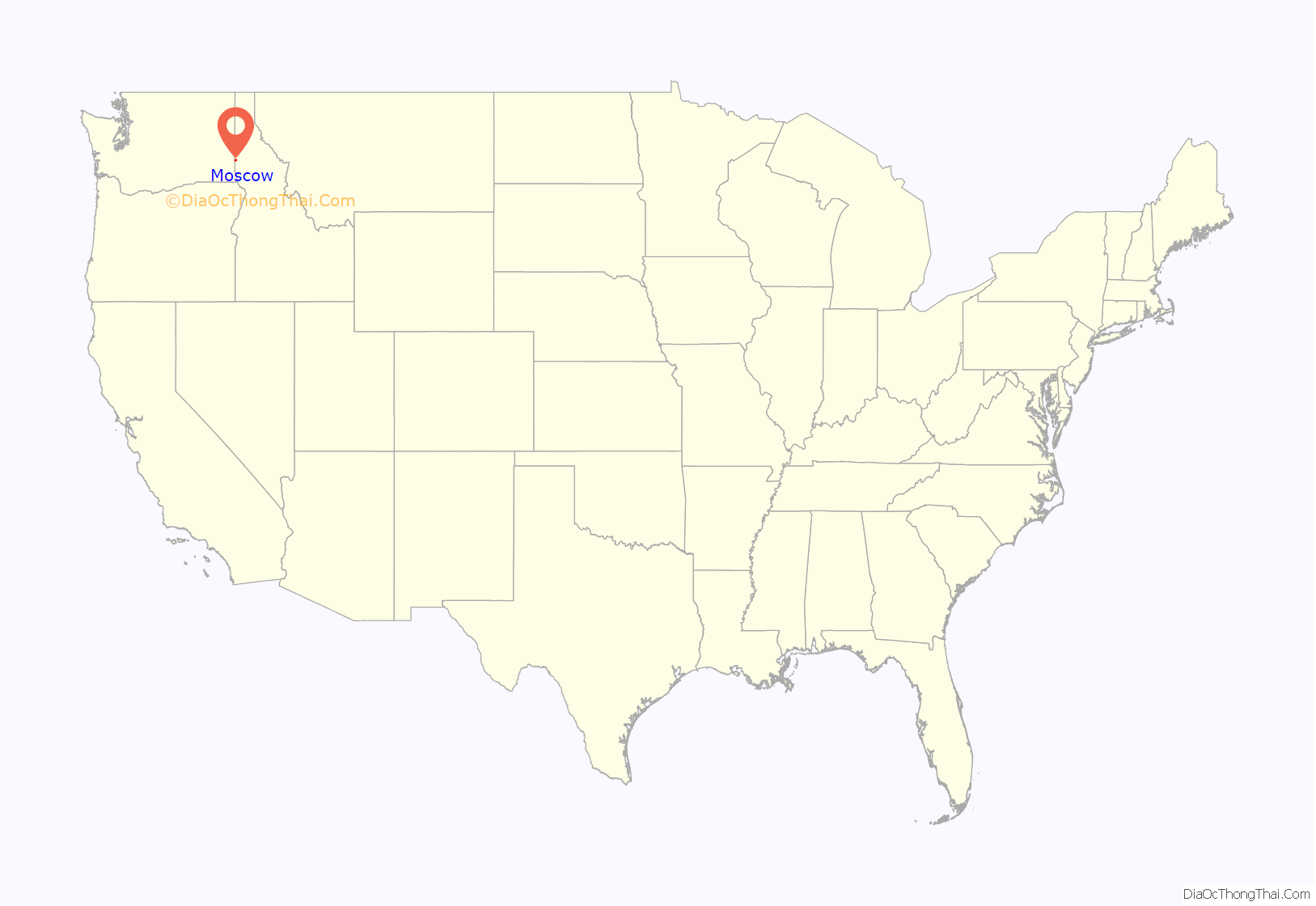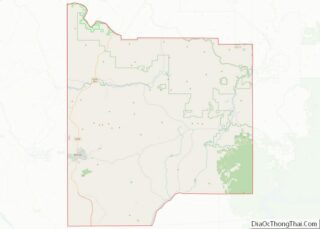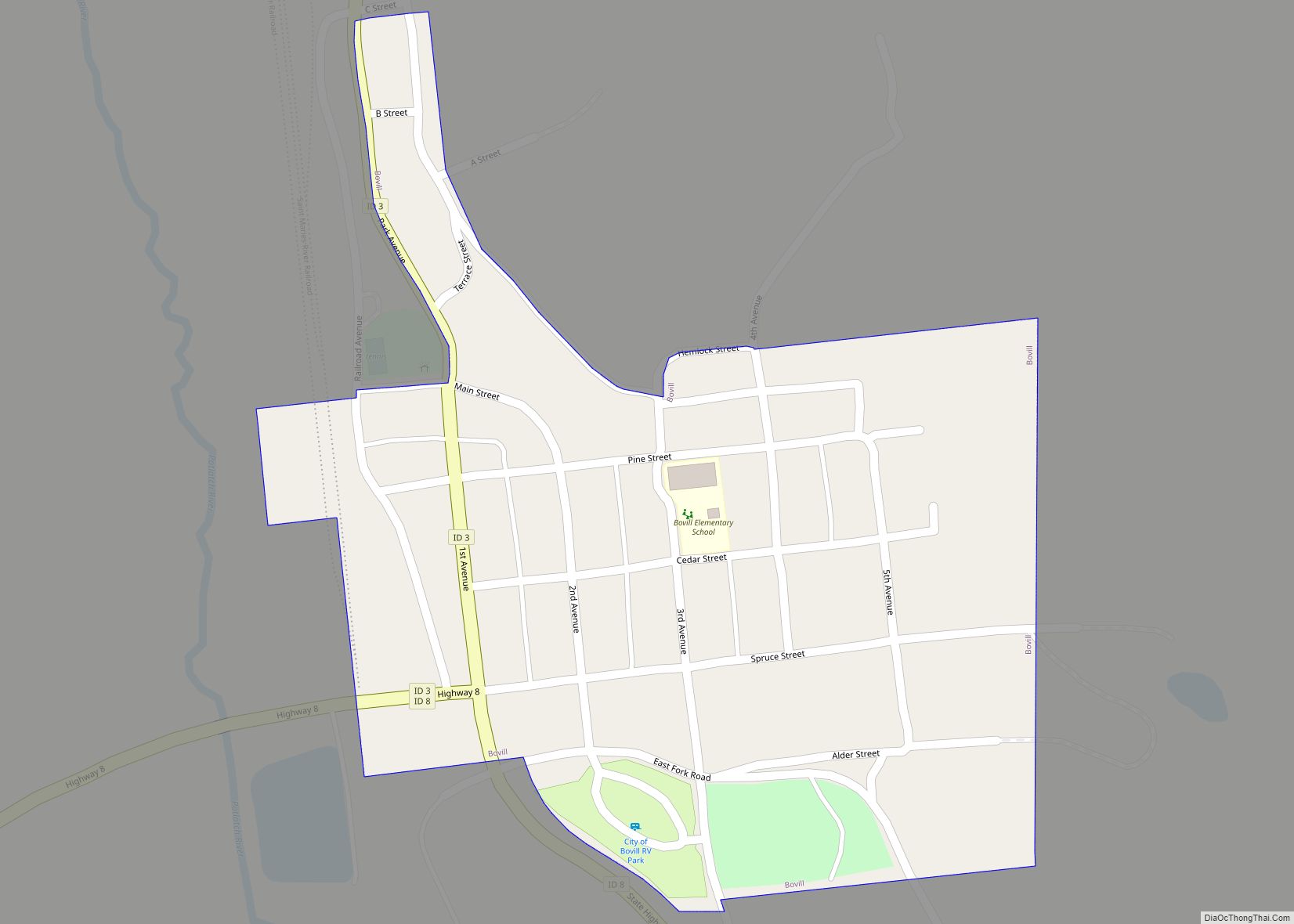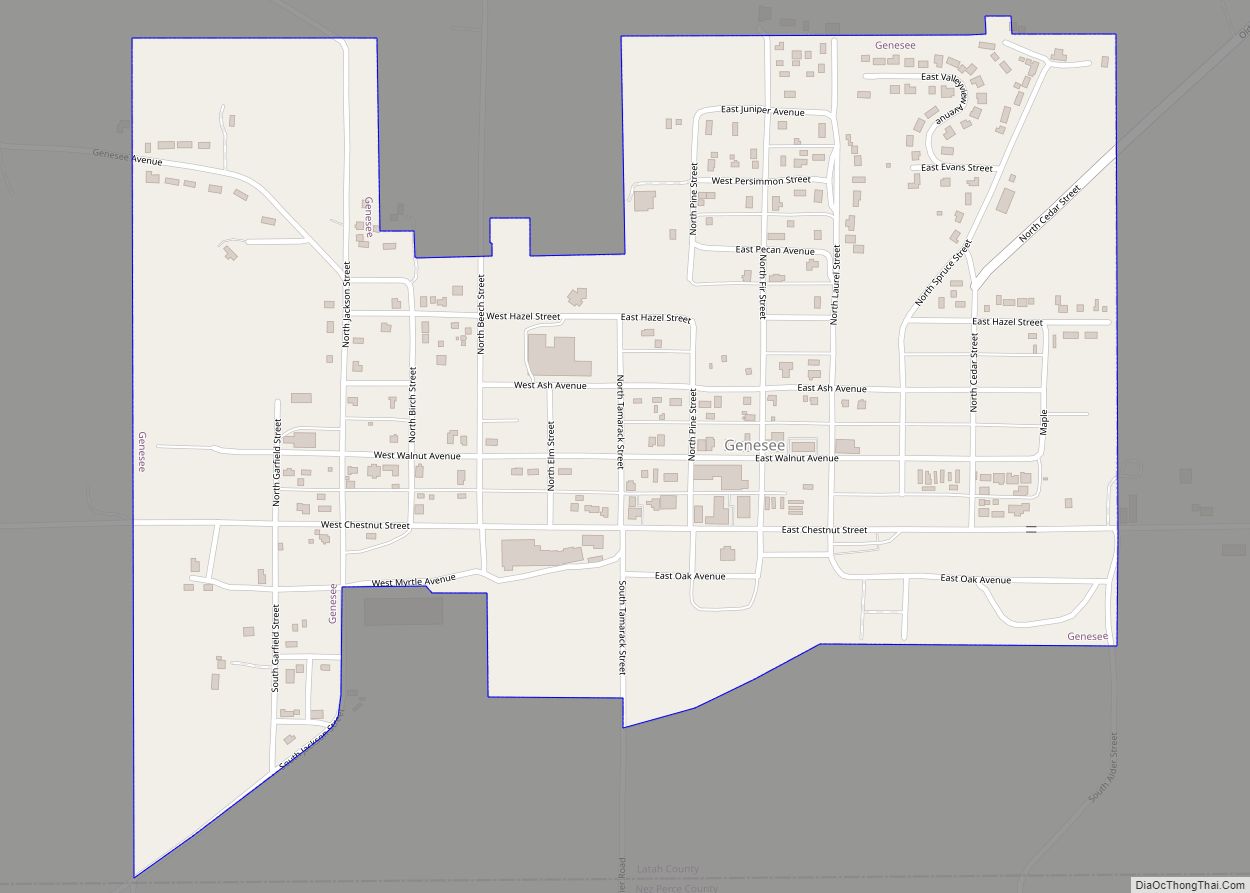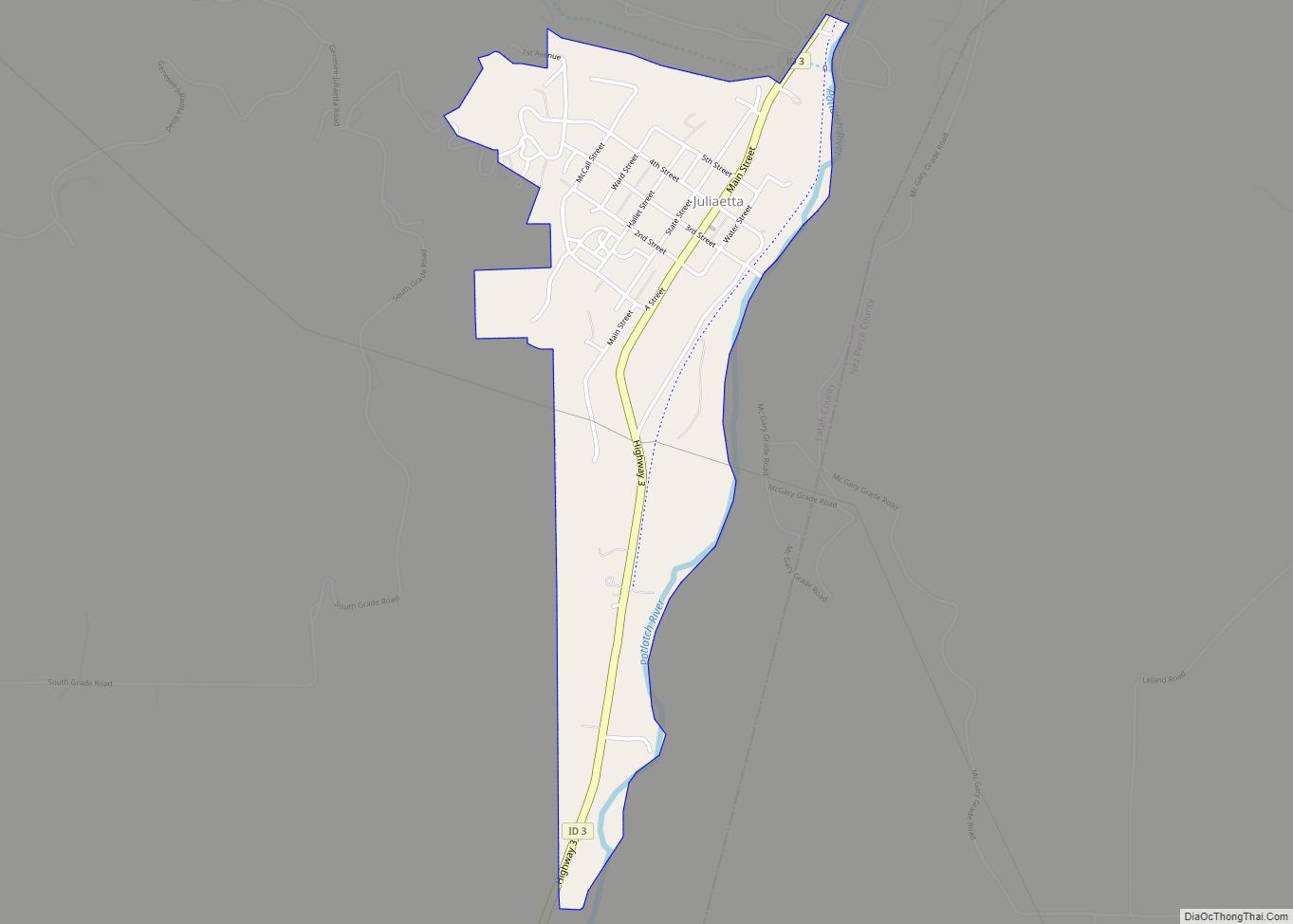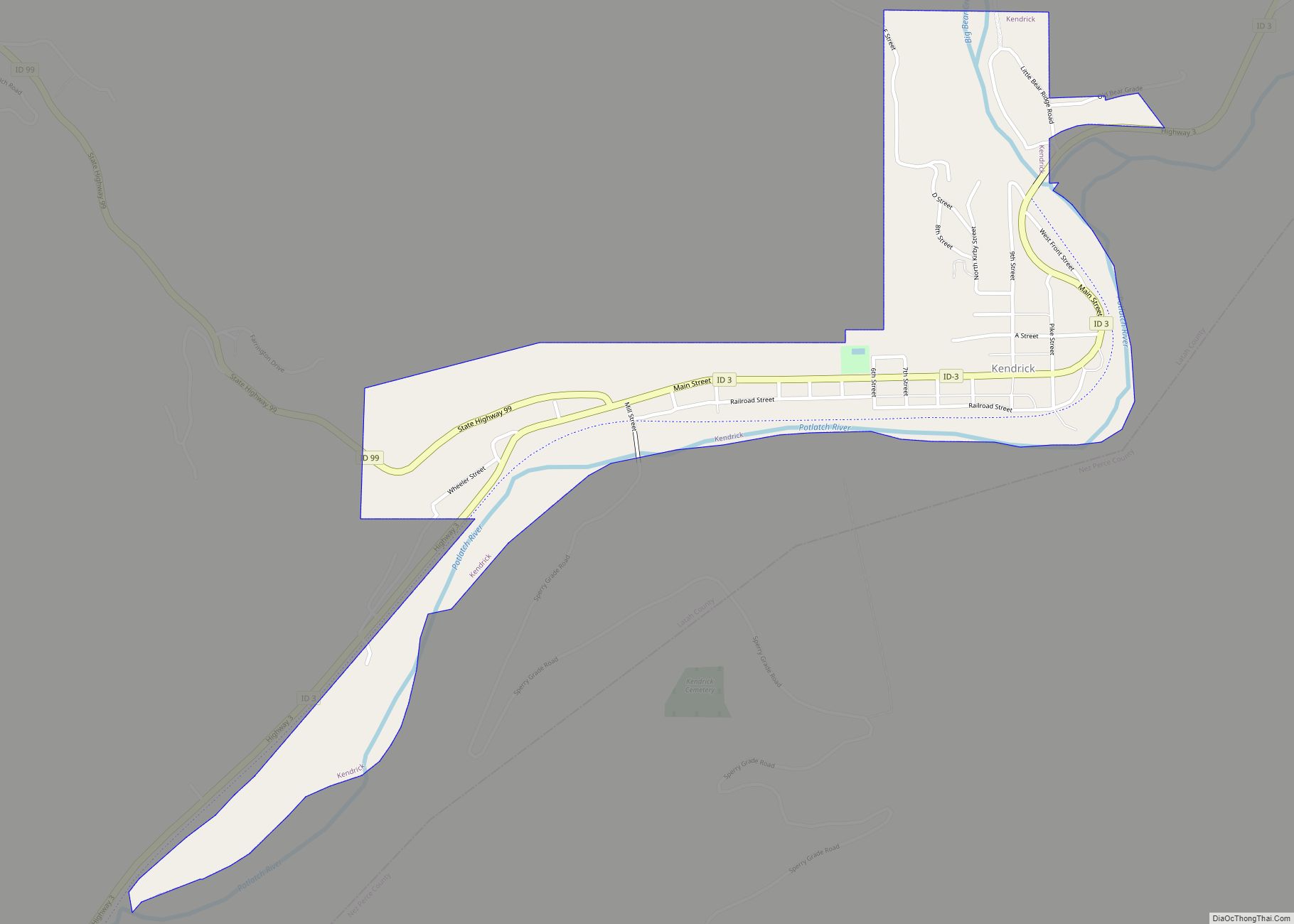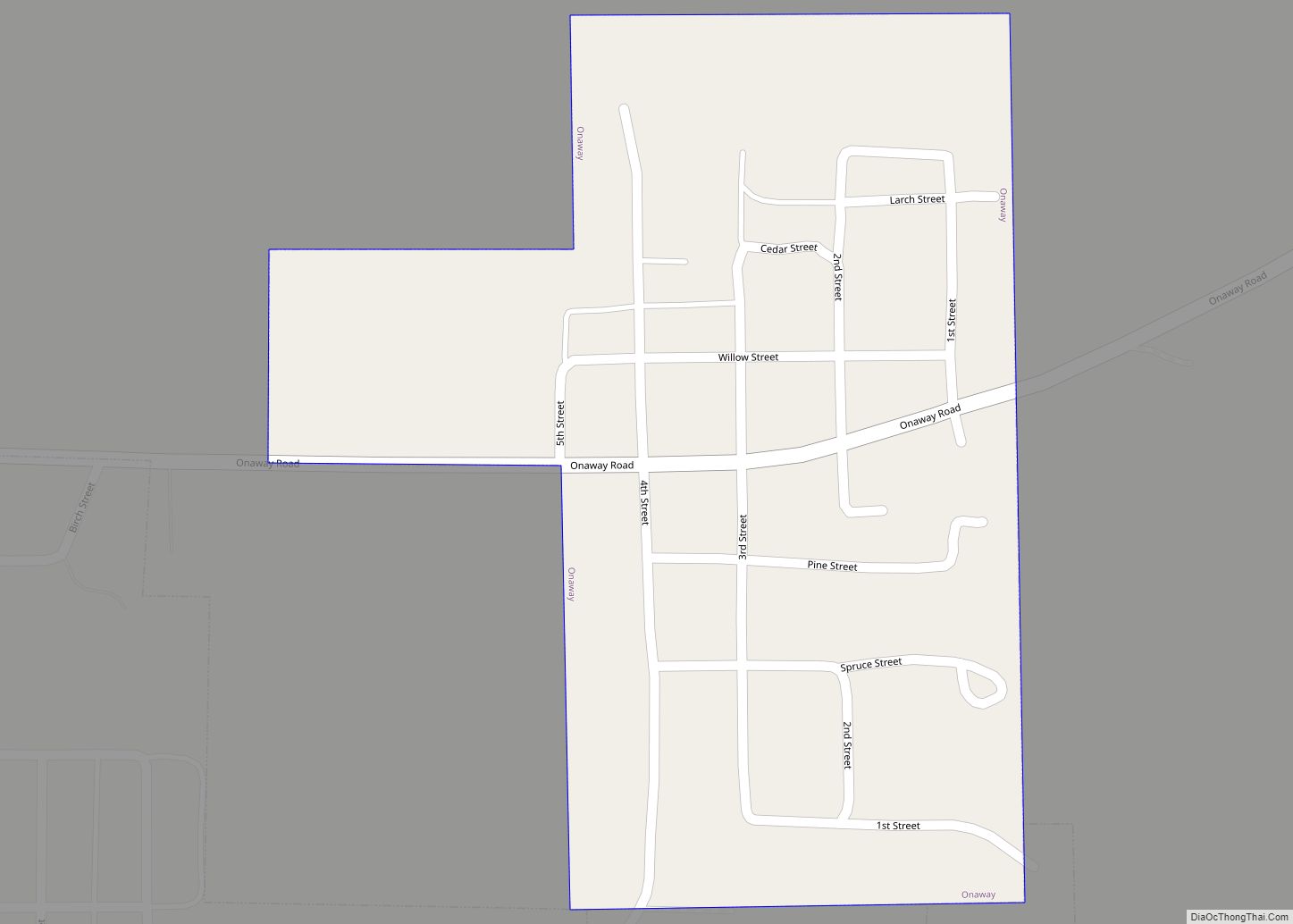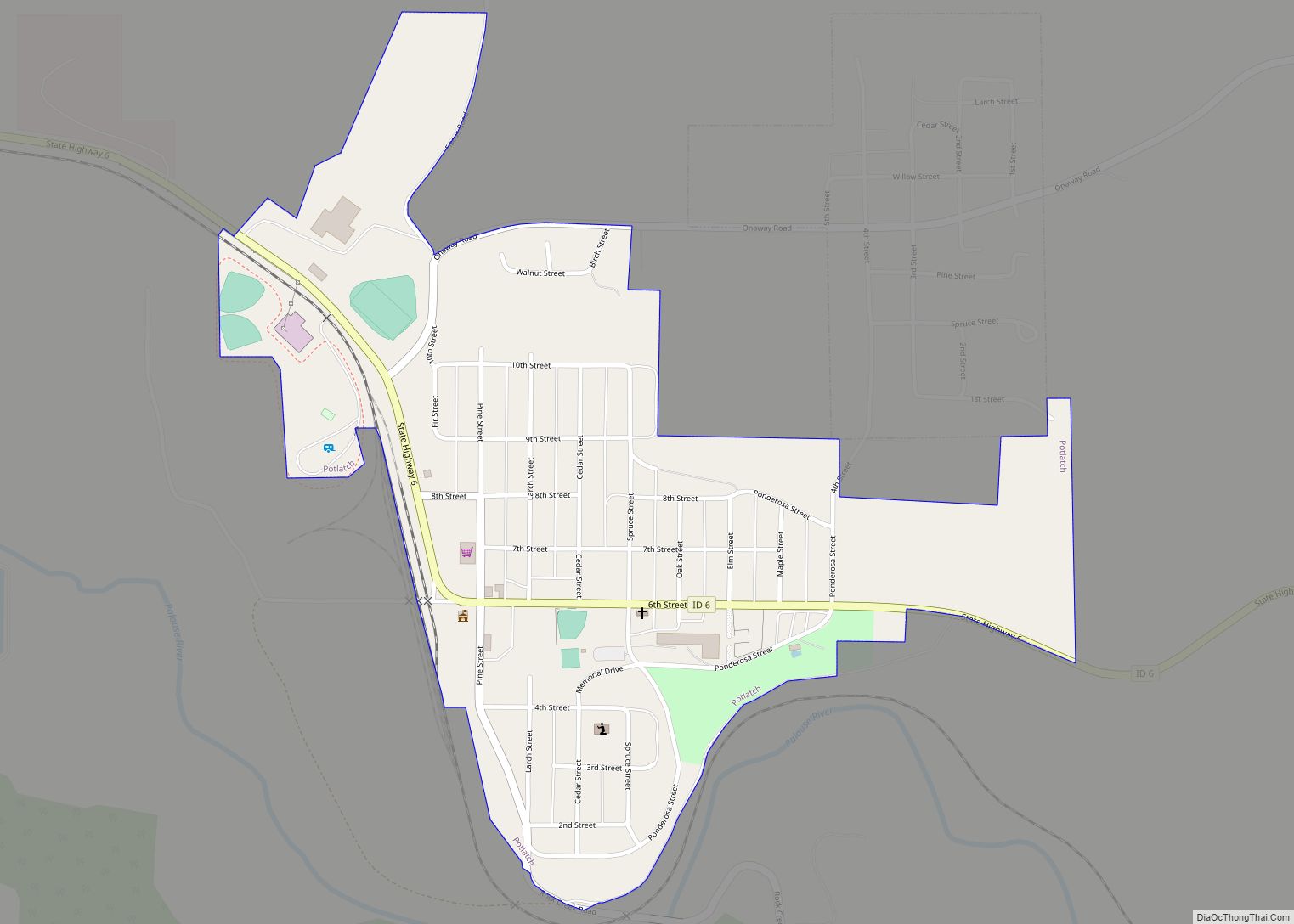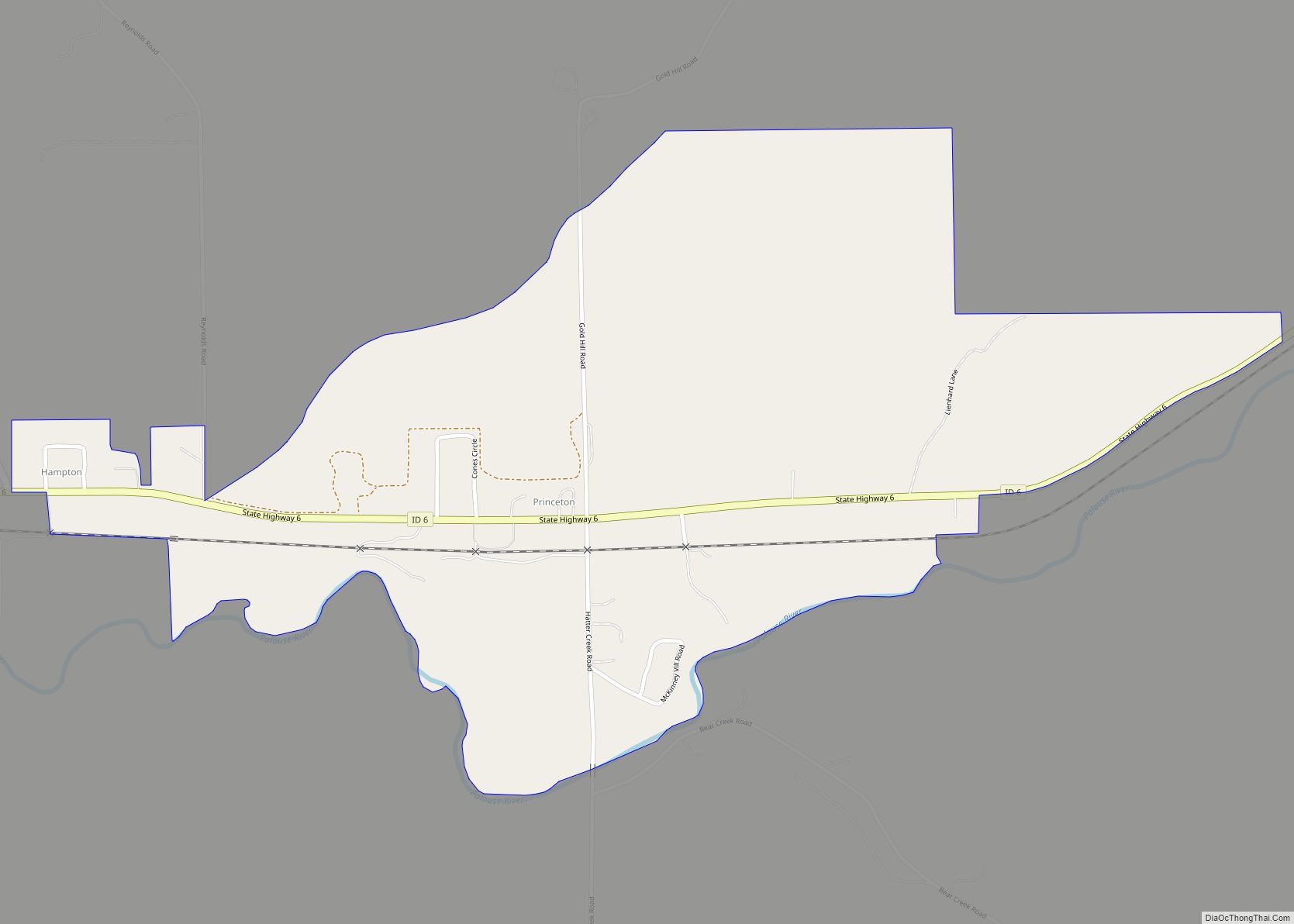Moscow (/ˈmɒskoʊ/ MOS-koh) is a city in North Central Idaho, United States. Located along the state border with Washington, it had a population of 25,435 at the 2020 census. The county seat and largest city of Latah County, Moscow is the home of the University of Idaho, the state’s land-grant institution and primary research university.
It is the principal city in the Moscow, Idaho Micropolitan Statistical Area, which includes all of Latah County. The city contains over 60% of the county’s population, and while the university is Moscow’s dominant employer, the city also serves as an agricultural and commercial hub for the Palouse region.
Along with the rest of the Idaho Panhandle, Moscow is in the Pacific Time Zone. The elevation of its city center is 2,579 feet (786 m) above sea level. Two major highways serve the city, passing through the city center: US-95 (north-south) and ID-8 (east-west). The Pullman–Moscow Regional Airport, four miles (6 km) west, provides limited commercial air service. The local newspaper is the Moscow-Pullman Daily News.
| Name: | Moscow city |
|---|---|
| LSAD Code: | 25 |
| LSAD Description: | city (suffix) |
| State: | Idaho |
| County: | Latah County |
| Elevation: | 2,579 ft (786 m) |
| Total Area: | 6.91 sq mi (17.90 km²) |
| Land Area: | 6.91 sq mi (17.89 km²) |
| Water Area: | 0.00 sq mi (0.01 km²) |
| Total Population: | 25,435 |
| Population Density: | 3,720.08/sq mi (1,436.28/km²) |
| ZIP code: | 83843 |
| Area code: | 208 |
| FIPS code: | 1654550 |
| GNISfeature ID: | 0400006 |
| Website: | ci.moscow.id.us |
Online Interactive Map
Click on ![]() to view map in "full screen" mode.
to view map in "full screen" mode.
Moscow location map. Where is Moscow city?
History
Community
Miners and farmers began arriving in the northern Idaho area after the Civil War. The first permanent settlers came to the Moscow area 152 years ago in 1871. The abundance of camas bulbs, a favorite fodder of pigs brought by the farmers, led to naming the vicinity “Hog Heaven.” When the first US post office opened in 1872, the town was called “Paradise Valley,” but the name changed to “Moscow” in 1875. The name Paradise persists in the main waterway through town, Paradise Creek, which originates at the west end of the Palouse Range, flows south to the Troy Highway, and west to Pullman where it enters the South Fork of the Palouse River.
Name
Historians have disputed the precise origin of the name Moscow. There is no conclusive proof that it is connected to the Russian capital, though various accounts suggest it purposely evoked the Russian city or was named by Russian immigrants. Another account claims that the name derives from a Native American tribe named “Masco”. Early settlers reported that five local men met to choose a proper name for the town, but could not agree. The postmaster, Samuel Neff, then completed the official papers for the town and chose Moscow for the name. Neff was born in Moscow, Pennsylvania.
By 1875, the town had a business district that was a center of commerce for the region. By 1890, the Oregon Railroad and Navigation Company’s rail line (later the Union Pacific) and the Northern Pacific railroad line helped boost the town’s population to 2,000.
Copy of a letter from Northern Pacific Railway agent in Moscow, likely R.W. Morris, to C.E. Arney, the Northern Pacific’s Western Immigration and Indian Agent in Spokane, Washington. Arney wrote all station agents in Idaho on May 12, 1922, requesting the origin of the names of their stations for the NP’s travel publication Wonderland, edited by Olin D. Wheeler. Moscow’s agent replied May 15, 1922, as follows:
Original document at the University of Montana, Mike and Maureen Mansfield Library, K. Ross Toole Archives, Collection 178, Box 210, Folder 10.
The capital of the Idaho Territory was relocated from Lewiston to Boise in December 1864. In the late 1880s, statehood for the Washington Territory was nearing. Because its commercial and transportation interests looked west, rather than south, the citizens of the Idaho Panhandle passionately lobbied for their region to join Washington, or to form an entirely separate state, rather than remain connected with the less accessible southern Idaho. To appease the residents of the north, the territorial legislature of Idaho in Boise placed the new land grant university in Moscow, which at the time was the largest city other than Boise in the state. The University of Idaho was chartered in January 1889, and first opened its doors to students in October 1892.
In March 1890, Moscow’s neighboring city, Pullman, became the home of Washington’s land grant institution. The college that became Washington State University opened its doors in January 1892. Washington entered the union as the 42nd state in November 1889 and Idaho entered next, eight months later, in July 1890.
Moscow City Hall and Old Post Office
Moscow Public Library
Members of the Pleiades Club and Ladies’ Historical Club formed a cooperative named the Women’s Reading Room Society and established a small library in the Browne building at the corner of Main and Second Streets in 1902.
In 1904, the committee planned to raise funds for a new library building. Andrew Carnegie promised funding of $10,000 if the community agreed to maintain a free public library at the rate of at least $1000 annually. Moscow voters approved a permanent tax in 1905 and with successful fundraising by subscription of local residents and businesses, coupled with the Carnegie library money, the library construction was begun in 1905. In March 1906, the Mission Style building was ready for occupancy. Later that month, a fire at the university’s Administration Building totally destroyed that structure, so the new library was used for university classes during the day and residents used the library in the evening. Beginning in 1907 the building was returned to full use as a library. The original library building (which is on the National Register of Historic Places) was expanded in 1931 and 1983. It houses a children’s room named for Moscow native Carol Ryrie Brink, the author of 1936 Newbery Medal winner Caddie Woodlawn.
In 2006, the Friends of the Library celebrated a Century of Service for the organization. The current organizational structure of library service encompasses all public libraries in Latah County as the Latah County Library District. The library enjoys broad support from the citizens of Moscow and the County and is also supported by the Idaho Commission for Libraries (formerly the Idaho State Library.)
The Moscow Public Library currently houses about 60% of Latah County Library District’s 100,000 volume collection. Administrative, technical, youth services, and branch services offices for the Library District are all housed at this location as well. The library offers year-round programming for all ages, including storytimes and a summer reading program for children, book clubs for teenagers and adults, and presentations by outside experts and organizations. The library also offers public Internet access computers as well as free wifi.
The library serves as resource for all the residents of Moscow, or as one essayist (Ellis Clark) in the 2006 contest states, “When time, money, or circumstances bind you to one locale, the Library is your passport for travel.”
1970 to 2009
The opening of Moscow Mall (now Eastside Marketplace) and Palouse Empire Mall (now Palouse Mall) in the late 1970s shifted many retail businesses away from the aging city center, with buildings dating to the 1890s. The city developed a revitalization project for downtown in the early 1970s that included a major traffic revision, which was enacted in 1981. Traffic from US 95 on Main Street was diverted a block away to one-way corridors on Washington (northbound) and Jackson (southbound) streets, to alleviate congestion and improve pedestrian safety and the overall city center experience. Main Street was converted from four busy lanes with metered parallel parking to two lanes of local retail traffic with free diagonal parking; its sidewalks were modified and trees were added. At the north end of Moscow, southbound highway traffic divided west at ‘D’ Street to Jackson and returned to Main at 8th; the northbound route divided east at 8th, but returned to Main four blocks earlier in the north end, at 1st Street.
The original 90-degree couplets of 1981 used existing streets of the grid. Planners intended these as temporary, but they remained for years. The primary safety hazard was inexperienced truck drivers—excessive speed through the tight corners led to toppled loads and subsequent traffic snarls, with occasional damage to adjacent structures. The new, straighter couplets at the north end are both over a block in length and eliminated existing structures. The return couplet from Washington Street runs from 1st Street to beyond ‘A’ Street; it eliminated the original front portion (white stucco chapel) of the Corner Club tavern at the northeast corner of ‘A’ and Main, which was demolished in early 1991 after staving off its elimination for over a decade. The building on the southeast corner, the Idaho Hotel, built in 1890, was razed for the traffic project in 1977 and was a vacant lot for over a decade.
The first of the new couplets was completed during the summer of 1991. The new southbound couplet to Jackson Street was completed the following year in 1992 and begins north of ‘C’ Street. It eliminated a former service station at the northwest corner of ‘C’ and Main, which had been converted to other retail for over a decade. The critical couplet at the south end of the city was delayed several times for various reasons. Completed in 2000, it is two blocks south and one block east of the 1981 divider at 8th Street. After Sweet Avenue, northbound Main Street bends a block east to align with northbound one-way Washington Street, intersecting the two-way Troy Highway from the southeast. Southbound US 95 traffic joins the intersection from the northwest, arriving on a one-way diagonal from Jackson Street. Agricultural buildings on the block between Jackson and Main (College St. to Lewis St.) were razed in the late 1990s to complete this new corridor. The completion of the south couplet allowed Gritman Medical Center to expand southward, over Eighth Street.
Another significant change to local commerce was the increase of the state’s legal drinking age to 21 in April 1987, after nearly fifteen years at age 19. Many establishments that relied on revenues from 19- and 20-year-olds from the two university communities had to adjust or cease operations. Prior to the lowering to 19 in July 1972, the drinking age in Idaho was 20 for beer and 21 for liquor and wine.
A fixture of the Moscow skyline for nearly a century, the concrete grain elevators on south Main Street were demolished in March 2007. Located on the southwest corner of 8th & Main, the elevators were last operated by the Latah County Grain Growers. The other major concrete elevator complex, on Jackson Street south of 6th, was also slated for the wrecking ball. Idle since 2005, a preservationist group saved it in 2007. Its newer large-diameter metal silo hosted summer theater productions in 2011.
2010 to present
Moscow is known internationally as the location of Christ Church and its associated ministries: Canon Press and New Saint Andrews College, as well as Logos School. Crawford Gribben suggests that Moscow is “America’s most postmillennial town”, since the town’s two explicitly postmillennial congregations (Christ Church and Trinity Reformed Church), make up about 10% of the town’s permanent population.
In the early morning hours of November 13, 2022, four University of Idaho students were stabbed to death in an off-campus rented home in Moscow by one or more attackers using one or more long knives. The authorities have identified Bryan Kohberger from Albrightsville, Pennsylvania as a suspect.
Moscow Road Map
Moscow city Satellite Map
Geography
Main Street runs north-south through Moscow along the 117th meridian west.
According to the United States Census Bureau, the city has a total area of 6.85 square miles (17.7 km), all of it land.
Moscow lies on the eastern edge of the Palouse region of north central Idaho in the Columbia River Plateau. East of the city is a valley within the mountains of the Palouse Range to the northeast, whose highest point is Moscow Mountain at 4,983 feet (1,519 m) above sea level. The less prominent Paradise Ridge at 3,702 feet (1,128 m) and Tomer Butte at 3,474 feet (1,059 m) are southeast of the city. Paradise Creek, with headwaters on Moscow Mountain to the northeast, flows through Moscow, then crosses the state border and joins the south fork of the Palouse River near Pullman, which eventually drains into the Snake River and Columbia River on its way to the Pacific Ocean.
The geology in and around Moscow represents varied formations: very old intrusive granite structures of the Jurassic−Eocene Idaho Batholith, fertile fields atop rolling hills of deep Pleistocene loess of the Palouse Formation deposited after the last ice age by westerly winds, and flood-worn channels of the Columbia River Basalt Group.
There is a variety of flora and fauna within the vicinity of Moscow. An amphibian, the Rough-skinned Newt, has a disjunctive population at Moscow; this species is found typically along the Pacific coast of the US. The city sits at the boundary between the Palouse grasslands and wheat fields, and the conifer forests of the Rocky Mountains to the east.
Climate
According to the Köppen climate classification system, Moscow has either a warm-summer Mediterranean climate (Csb) or a dry-summer continental climate (Dsb).
See also
Map of Idaho State and its subdivision:- Ada
- Adams
- Bannock
- Bear Lake
- Benewah
- Bingham
- Blaine
- Boise
- Bonner
- Bonneville
- Boundary
- Butte
- Camas
- Canyon
- Caribou
- Cassia
- Clark
- Clearwater
- Custer
- Elmore
- Franklin
- Fremont
- Gem
- Gooding
- Idaho
- Jefferson
- Jerome
- Kootenai
- Latah
- Lemhi
- Lewis
- Lincoln
- Madison
- Minidoka
- Nez Perce
- Oneida
- Owyhee
- Payette
- Power
- Shoshone
- Teton
- Twin Falls
- Valley
- Washington
- Alabama
- Alaska
- Arizona
- Arkansas
- California
- Colorado
- Connecticut
- Delaware
- District of Columbia
- Florida
- Georgia
- Hawaii
- Idaho
- Illinois
- Indiana
- Iowa
- Kansas
- Kentucky
- Louisiana
- Maine
- Maryland
- Massachusetts
- Michigan
- Minnesota
- Mississippi
- Missouri
- Montana
- Nebraska
- Nevada
- New Hampshire
- New Jersey
- New Mexico
- New York
- North Carolina
- North Dakota
- Ohio
- Oklahoma
- Oregon
- Pennsylvania
- Rhode Island
- South Carolina
- South Dakota
- Tennessee
- Texas
- Utah
- Vermont
- Virginia
- Washington
- West Virginia
- Wisconsin
- Wyoming
